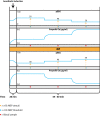The influence of depth of anesthesia and blood pressure on muscle recorded motor evoked potentials in spinal surgery. A prospective observational study protocol
- PMID: 33507473
- PMCID: PMC8497310
- DOI: 10.1007/s10877-020-00645-1
The influence of depth of anesthesia and blood pressure on muscle recorded motor evoked potentials in spinal surgery. A prospective observational study protocol
Abstract
For high-risk spinal surgeries, intraoperative neurophysiological monitoring (IONM) is used to detect and prevent intraoperative neurological injury. The motor tracts are monitored by recording and analyzing muscle transcranial electrical stimulation motor evoked potentials (mTc-MEPs). A mTc-MEP amplitude decrease of 50-80% is the most common warning criterion for possible neurological injury. However, these warning criteria often result in false positive warnings. False positives may be caused by inadequate depth of anesthesia and blood pressure on mTc-MEP amplitudes. The aim of this paper is to validate the study protocol in which the goal is to investigate the effects of depth of anesthesia (part 1) and blood pressure (part 2) on mTc-MEPs. Per part, 25 patients will be included. In order to investigate the effects of depth of anesthesia, a processed electroencephalogram (pEEG) monitor will be used. At pEEG values of 30, 40 and 50, mTc-MEP measurements will be performed. To examine the effect of blood pressure on mTc-MEPs the mean arterial pressure will be elevated from 60 to 100 mmHg during which mTc-MEP measurements will be performed. We hypothesize that by understanding the effects of depth of anesthesia and blood pressure on mTc-MEPs, the mTc-MEP monitoring can be interpreted more reliably. This may contribute to fewer false positive warnings. By performing this study after induction and prior to incision, this protocol provides a unique opportunity to study the effects of depths of anesthesia and blood pressure on mTc-MEPs alone with as little confounders as possible. Trial registration number NL7772.
Keywords: Blood pressure; Depth of anesthesia; Intraoperative neurophysiological monitoring; Motor evoked potentials.
© 2021. The Author(s).
Conflict of interest statement
ARA: The research group/department to which he belongs has received Grants and Funding from The Medicines Company, Carefusion/Becton Dickinson. He has performed sponsor-initiated phase 1 studies (payment to institution) for The Medicines Company and Rigel; and he has performed paid consultancy work (payment to institution) for Johnson & Johnson, Carefusion, The Medicines Company, Philips and Ever Pharma. He is an editor of the British Journal of Anaesthesia.
All other authors report no conflicts of interest or competing interests in any concept discussed in this article.
Subjects can leave the study at any time before start of surgery or after surgery for any reason if they wish to do so without any consequences. The investigator can decide to withdraw a subject from the study for urgent medical reasons. Data collected during surgery will still be used if a patient decides to withdraw after surgery. When patients decide to withdraw before surgery, all already collected data will be destroyed. No financial rewards are provided for participating in this study.
Figures


Comment in
-
IONM protocols.J Clin Monit Comput. 2021 Oct;35(5):957-958. doi: 10.1007/s10877-021-00650-y. Epub 2021 Jan 18. J Clin Monit Comput. 2021. PMID: 33459946 No abstract available.
References
-
- Fehlings MG, Brodke DS, Norvell DC, Dettori JR. The evidence for intraoperative neurophysiological monitoring in spine surgery: does it make a difference? Spine (Phila Pa 1976). 2010;35:S37–46 (cited 2018 May 21). https://insights.ovid.com/crossref?an=00007632-201004201-00006. - PubMed
-
- MacDonald DB, Skinner S, Shils J, Yingling C, American Society of Neurophysiological Monitoring. Intraoperative motor evoked potential monitoring—a position statement by the American Society of Neurophysiological Monitoring. Clin Neurophysiol. 2013;124:2291–316 (cited 13 May 2018). http://www.ncbi.nlm.nih.gov/pubmed/24055297. - PubMed
-
- Deletis V, Sala F. Intraoperative neurophysiological monitoring of the spinal cord during spinal cord and spine surgery: a review focus on the corticospinal tracts. Clin Neurophysiol. 2008;248–64. https://ac.els-cdn.com/S1388245707006037/1-s2.0-S1388245707006037-main.p...9209-90cf3c282be3&acdnat=1525852852_6be5628e8a8edbdcfe7d42c13a88f104. - PubMed
-
- Sala F, Palandri G, Basso E, Lanteri P, Deletis V, Faccioli F, et al. Motor evoked potential monitoring improves outcome after surgery for intramedullary spinal cord tumors: a historical control study. Neurosurgery. 2006;58:1129–43 (cited 28 May 2019) . http://www.ncbi.nlm.nih.gov/pubmed/16723892. - PubMed
-
- Macdonald DB. Overview on criteria for MEP monitoring. J Clin Neurophysiol. 2017;34:4–11 (cited 14 Nov 2018). https://insights.ovid.com/pubmed?pmid=28045852. - PubMed
MeSH terms
LinkOut - more resources
Full Text Sources
Other Literature Sources
Medical

